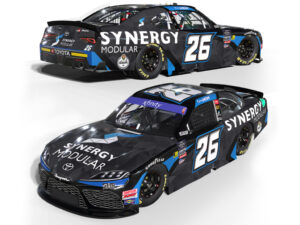Notes of Interest
● The EchoPark Automotive Grand Prix Sunday at Circuit of the Americas (COTA) in Austin, Texas, is the first of five road-course races on the 2024 NASCAR Cup Series schedule. After COTA, the series’ next road-course race is June 9 at Sonoma (Calif.) Raceway. The three remaining road-course races after Sonoma are July 7 on the streets of downtown Chicago, Sept. 15 at Watkins Glen (N.Y.) International, and Oct. 12 at the Charlotte (N.C.) Motor Speedway Roval.
● This weekend marks NASCAR’s fourth appearance at COTA. The 3.426-mile, 20-turn road course was constructed in 2011 and has been America’s home to Formula One since the global motorsports series returned to America with the 2012 United States Grand Prix. The United States Grand Prix dates back to 1950 when the Indianapolis 500 counted as a round of the world championship. Eleven times from 1950 to 1960, points scored at Indy were added to a Formula One driver’s season tally, and in 1959 America hosted two Formula One races when, in addition to Indianapolis, the United States Grand Prix was held at Sebring (Fla.) International Raceway. It served as the ninth and final round of the 1959 season. In 1960, Formula One moved to Riverside (Calif.) International Raceway before finally settling down for a 20-year tenure at Watkins Glen (1961-1980). From 1976 to 1980, Watkins Glen was joined by Long Beach, California, on the Formula One schedule, with the United States Grand Prix West taking place until 1983. After Watkins Glen fell off the calendar, Las Vegas took its place for two seasons (1981-1982) with the Caesars Palace Grand Prix being held on its hotel parking lot. In 1982, America hosted three Formula One races when, in addition to Long Beach and Las Vegas, Detroit was added to the schedule. Detroit hosted Formula One on a bumpy street circuit for seven years, with its last grand prix coming in 1988. Dallas made a one-race appearance in 1984, when Fair Park was converted to a Formula One circuit for the Dallas Grand Prix. Phoenix was next up for Formula One from 1989 to 1991 before a nine-year absence of the sport from America’s shores. But then Indianapolis Motor Speedway built a road course within the confines of the historic 2.5-mile oval and Formula One returned with the United States Grand Prix at Indianapolis from 2000 to 2007. Sadly, Formula One in America fell off the calendar again. It wasn’t until COTA was constructed, becoming the first purpose-built Formula One facility in the United States, that Formula One was able to return to America. In 2024, COTA is one of three Formula One stops in the United States, with the series first coming ashore May 3-5 for the Miami Grand Prix before Racing at COTA Oct. 18-20 for the United States Grand Prix, and culminating its three-race U.S. stint Nov. 22-24 with a race on Las Vegas’ famous Strip.
● Contrast best describes a lap around COTA. High speed and rapid changes of direction comprise the layout between turns two and 10, with this first sector akin to the Maggotts-Becketts-Chapel complex at the famed Silverstone Circuit in England. The end of the lap from turn 12 through turn 20 before hitting the frontstretch features low-speed combinations. The long backstraight, however, is where drivers want to retain as much speed as possible to either attack or defend through the tight turn 12. This corner, along with the uphill run to turn one and the hairpin in turn 11, provide good passing opportunities.
● Sunday’s EchoPark Automotive Grand Prix will mark Gragson’s second NASCAR Cup Series start at COTA. In his maiden Cup race at the track last year, he qualified 10th and finished 20th.
● Gragson has two NASCAR Xfinity Series starts at COTA as he competed at the track in 2021 and 2022. In his second and final Xfinity Series start at COTA, Gragson drove from his 12th-place starting spot to finish an impressive fourth.
● Across the NASCAR Cup Series, NASCAR Xfinity Series, NASCAR Craftsman Truck Series, ARCA Menards Series and NASCAR K&N Series, Gragson has made a total of 37 road-course starts – three in Cup, 21 in Xfinity, two in Trucks, one in ARCA and 10 in K&N – amassing four wins, 16 top-fives and 27 top-10s with 161 laps led.
● Gragson’s four road-course wins all came in the NASCAR K&N Series, and three were earned in a one-week stretch in September 2016. Gragson swept a pair of K&N Series West races at the Utah Motorsports Campus in Tooele, beating Todd Gilliland on Sept. 10 and then besting him again on Sept. 11, when Gragson took the lead from Gilliland on the last lap. Six days and 2,219 miles later at New Jersey Motorsports Park in Millville, Gragson scored his third straight road-course win, this time in the K&N Series East, where he beat Justin Haley. Gragson’s fourth and most recent road-course win was earned in the 2019 K&N Series West race at Sonoma (Calif.) Raceway, where he qualified second and led twice for 24 laps, including the final two, to take the victory over Daniel Hemric.
● The 2024 season marks the 15th year of partnership between Rush Truck Centers and Stewart-Haas Racing, and it’s a partnership that goes well beyond a design on a racecar. All Stewart-Haas racecars are transported via tractor-trailers from Rush Truck Centers, the premier service solutions provider to the commercial vehicle industry. And those tractor-trailers are supported by the RushCare Customer Support team of parts and service experts, who also provide concierge-level service for scheduling maintenance, technical support, mobile service dispatch and roadside assistance, along with help locating the nearest Rush Truck Centers dealer, and more. Rush Truck Centers is the largest network of commercial vehicle dealerships in North America with 150 locations in the United States and Ontario, Canada, and takes pride in its integrated approach to customer needs – from vehicle sales to aftermarket parts, service and body shop operations, plus financing, insurance, leasing and rental, as well as alternate fuel systems and other vehicle technologies.
Noah Gragson, Driver of the No. 10 Rush Truck Centers Ford Mustang Dark Horse
How would you rate yourself as a road-course driver?
“I would probably rate myself, on a scale of 1-10, as a seven on road courses. Not terrible, but always trying to improve. I felt like I picked up road-course Racing pretty well and had a lot of success in the Legend Car ranks and Bandoleros, and then moving on up into the K&N Series, I ran really well. I had opportunities to win some Truck races, ran in the top-five a lot and led laps in the Xfinity Series, but never got a win in either Trucks or Xfinity, but was always a contender. But then in the Cup Series, man, it’s challenging, everybody’s good. You used to have the road-course ringers, but now, not so much. I used to take a lot more pride in my road-course efforts coming up through the ranks, but now everybody’s so super good that I’m probably an average guy. I don’t think I’m terrible at it, but I’m not elite at it, either.”
Some guys like road courses, others don’t. Where do you stand when it comes to competing on road courses?
“We used to just have two or three, or maybe only one on the Truck schedule, and my thinking was, ‘Oh man, this’ll be cool, I’ll get to do something different.’ Now there are five or six road courses – at one point, there were seven on the schedule – so it’s a big chunk of our season. You have to be good at it, but I’d also say it’s just another race where you have to carry the same amount of intensity. It felt a little more unique and special when there was just a limited number of road courses.”
Three Cup Series starts on road courses – COTA, Charlotte Roval and Chicago Street Course – and 21 road-course starts in Xfinity, where you finished among the top-five nearly 50 percent of the time and top-10 all but three times. So, you’ve had success on road courses, but what makes success on road courses at the Cup level so much harder?
“Cup cars are definitely a lot different to drive than Trucks, Xfinity cars and K&N cars. They’re more like a sports car with the independent rear suspension, so just trying to figure that out – my first-ever road-course race in a Cup car came at the Roval in 2022 and the shifting, everything, is just a little bit different than what you’re used to. The brakes are massive, you can really push the braking zones, and you’re just hustling the car all the way around the racetrack. You can’t hit curbs as much because of the shock limiters where you used to just motor over curbs. They’re a lot more aggressive with the front steering, so you can maneuver very well with these cars, and they respond very well. It’s kind of a mix between an F1 car and one of the old stock cars like the Gen 6 stock car with how you get around these tracks. But with that being said, it’s been a little bit of a change of pace, but it’s been a lot of fun.”
What do you work on to become a better road-course racer?
“I think just constant reps in the sim has been the best for me. I’ve also worked with Carter Fartuch, who’s been a road-course instructor at the Skip Barber Racing School at COTA. Been there for two years now, got a lot of help from him, he’s been a big part of our road-course program the last two years, so that was really good and I appreciate his knowledge. On top of that, just a lot of laps in the simulator seeing where you can try different things and improve your times.”
The current Cup cars seem exceptionally suited to road-course Racing to where they’re forgiving and drivers aren’t penalized for mistakes. Because of that, it seems like there’s more rooting and gouging out on the racetrack than ever before. What’s your take?
“I don’t know if it’s harder to pass, but everyone’s really, really close on their lap times, so the final restarts are just chaos. We saw at COTA last year where it took three or four green-white-checkereds to get the finish and everyone’s like, you’ve got to screw the other guy before he screws you on a restart. If you spin him out, so be it, or else you’re going to be the one being spun out. We were running eighth there last year and got spun out and finished 20th. It makes it exciting for the fans, I can say that.”
With track position at such a premium on road courses, can you afford to be nice, or do you need to have a selfish and unforgiving attitude?
“I definitely think it ramps up late in the race. You let guys go in certain areas, like if it’s the middle of the race and there’s no point in abusing your stuff, especially if you’re not the leader or going for the lead, there’s no point. I always felt like there’s time lost to the leader when you’re battling a guy, you’re just slowing each other down. You’re not going to get lapped, but you’re still slowing each other down. If he runs you down, just point him by and let him go because you’re only losing time to the leader.”
Take me for a lap at COTA. What parts do you like and what parts are a challenge, and what does it take to make a quick lap?
“I like COTA a lot. It’s a lot of fun, but all of it is challenging. Going up the hill into turn one, braking, not turning too early into turn one, is crucial. It’s pretty sketchy going through turn two, the righthander down the hill, you start to get to the esses section and that takes a lot of discipline not to overdrive and get out of rhythm through there. And then it’s a really flowy track all the way through (turns) six, seven, that whole first portion, where your car placement is at the exit of the corner, which sets up your entry for the next corner, so you’re always thinking two, three corners ahead on how you want to be positioned. You’re not just thinking about, ‘Hey, if I can get into this corner fast, I can go wherever I want on exit.’ That’s going to hurt you. Then you get through turn 10, you’re going down the hill wide open, hitting the shock limiters, you’re out of control, sideways, grabbing gears. You get down into turn 11, there’s a really tight hairpin, where the transition of asphalt goes from new asphalt to old asphalt in the corner and it’s really easy to lock the left-front brake up. You take that long, sharp lefthander onto the long back straightaway and you want to get a big, good run out of that corner and drive in deep into the next hairpin. Then you’ve got a short chute into the stadium section, and that’s a really flowy and different set of corners just because you can change your line up and still be competitive. It’s easy to get lost, but it’s also easy to have different options when you’re Racing guys and cross guys over. Then you go through the triple righthander and once you finish that, you’re on the edge of out of control, driving off the left-rear tire, kind of skating the thing, sliding out to the left exit of (turns) 16, 17, 18. You get into turn 19, which is a really fast timing corner, lefthander, and then into turn 20, which is the final corner on the racetrack, a little 90-degree lefthander. It kind of feels off-camber and it’s easy to overdrive it, old asphalt, and easy to lock the left-front tire up and kind of miss the corner. It’s a tough, challenging racetrack. There’s no one corner that I love, but there’s no one corner that I hate. They’re all a challenge, but they’re all a lot of fun.”
Do you have a go-to restaurant in Austin?
“Terry Black’s BBQ. I like to get the brisket and the corn – the cream jalapeno corn, which is good. But my all-time favorite for barbecue is going to Hard Eight (BBQ) in Dallas when we race at Texas Motor Speedway. That place is awesome.”
TSC PR
Post Views: 5
#Rush #Truck #Centers #Racing #Noah #Gragson #COTA #Advance #Speedway #Digest #Home #NASCAR #News





More Stories
RACE ADVANCE: Corey Heim at Dover Motor Speedway – Speedway Digest – Home for NASCAR News
Video: Ferrari to address SF-24 struggles in slower sections amid suspension setup
F1 Commission defers decision on points change and approves new rear cameras